University Essay: Gender, Sex, and Diversity in Society Analysis
VerifiedAdded on 2020/05/01
|7
|1636
|35
Essay
AI Summary
This essay delves into the sociological complexities of gender, sex, and diversity, examining their impact on contemporary society. It addresses the importance of diversity in corporate boards, highlighting the significance of varied perspectives and experiences. The essay explores the concept of whiteness, its social construction, and its implications for racial identity and power dynamics, particularly in contexts like Australia. Furthermore, it analyzes the construction of identity, emphasizing the influence of media representations on shaping perceptions of gender, race, and social categories. The essay underscores the social construction of both gender and race, emphasizing the media's crucial role in shaping these perceptions and the ongoing struggles for identity and social construction. The document draws on various academic sources to support its arguments, providing a comprehensive analysis of these interconnected sociological concepts.
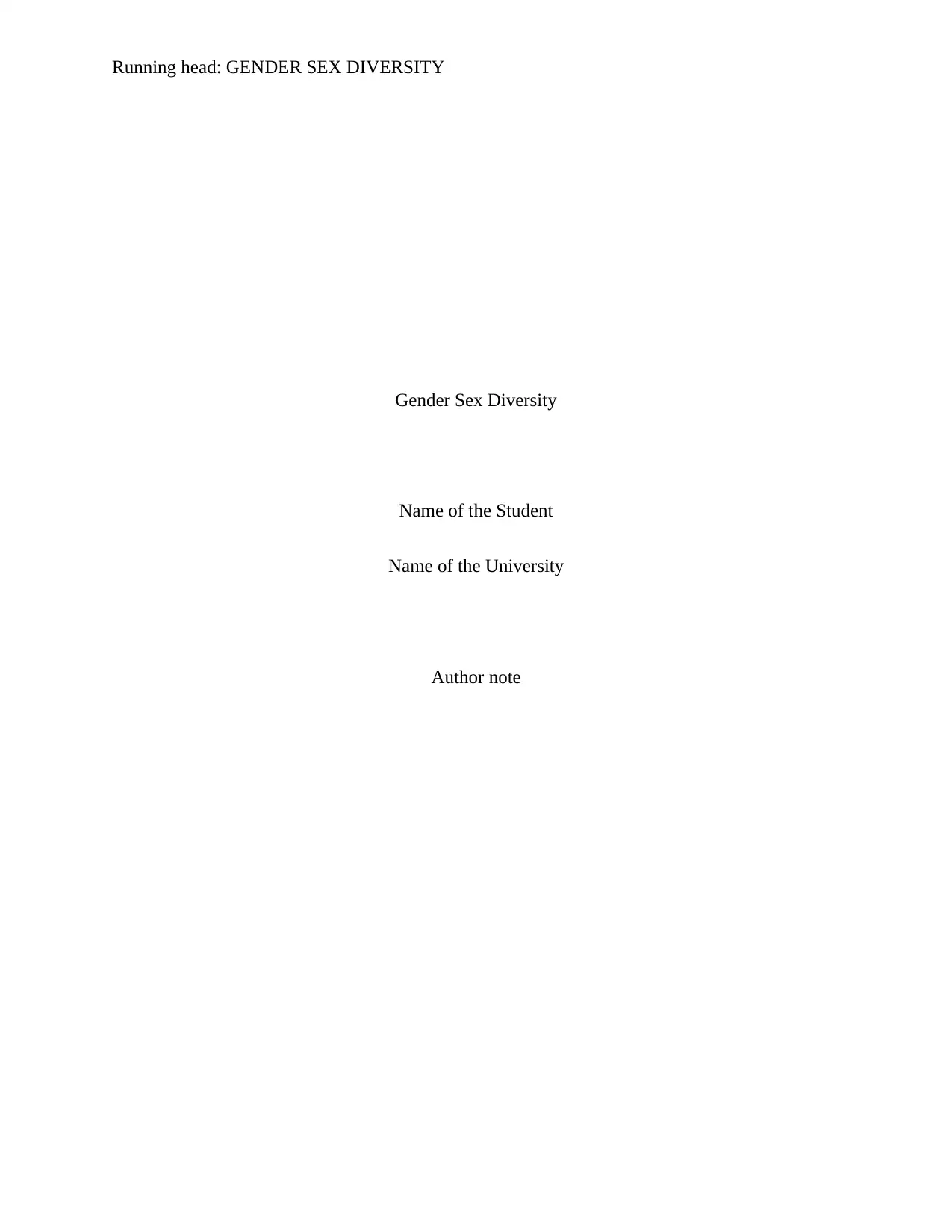
Running head: GENDER SEX DIVERSITY
Gender Sex Diversity
Name of the Student
Name of the University
Author note
Gender Sex Diversity
Name of the Student
Name of the University
Author note
Paraphrase This Document
Need a fresh take? Get an instant paraphrase of this document with our AI Paraphraser
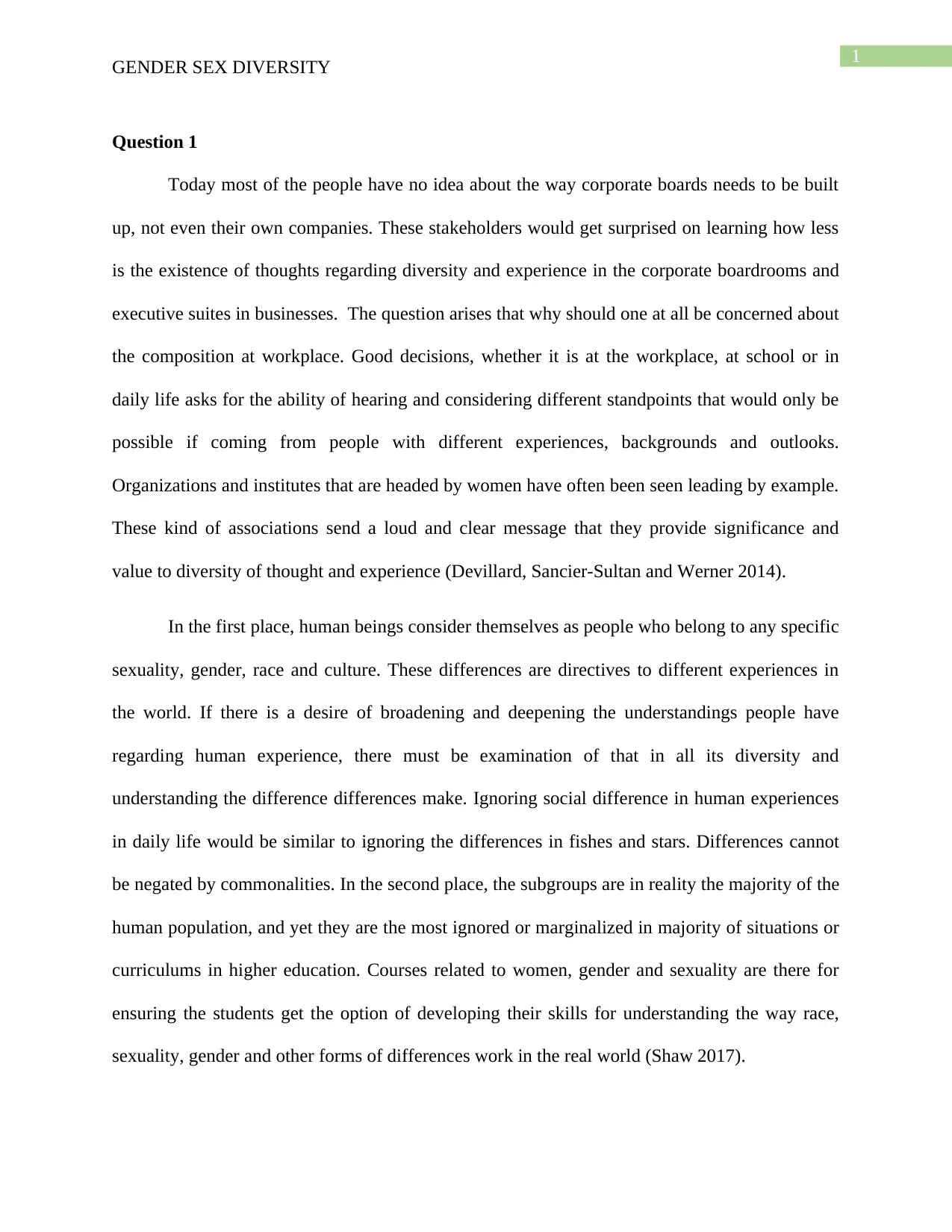
1
GENDER SEX DIVERSITY
Question 1
Today most of the people have no idea about the way corporate boards needs to be built
up, not even their own companies. These stakeholders would get surprised on learning how less
is the existence of thoughts regarding diversity and experience in the corporate boardrooms and
executive suites in businesses. The question arises that why should one at all be concerned about
the composition at workplace. Good decisions, whether it is at the workplace, at school or in
daily life asks for the ability of hearing and considering different standpoints that would only be
possible if coming from people with different experiences, backgrounds and outlooks.
Organizations and institutes that are headed by women have often been seen leading by example.
These kind of associations send a loud and clear message that they provide significance and
value to diversity of thought and experience (Devillard, Sancier-Sultan and Werner 2014).
In the first place, human beings consider themselves as people who belong to any specific
sexuality, gender, race and culture. These differences are directives to different experiences in
the world. If there is a desire of broadening and deepening the understandings people have
regarding human experience, there must be examination of that in all its diversity and
understanding the difference differences make. Ignoring social difference in human experiences
in daily life would be similar to ignoring the differences in fishes and stars. Differences cannot
be negated by commonalities. In the second place, the subgroups are in reality the majority of the
human population, and yet they are the most ignored or marginalized in majority of situations or
curriculums in higher education. Courses related to women, gender and sexuality are there for
ensuring the students get the option of developing their skills for understanding the way race,
sexuality, gender and other forms of differences work in the real world (Shaw 2017).
GENDER SEX DIVERSITY
Question 1
Today most of the people have no idea about the way corporate boards needs to be built
up, not even their own companies. These stakeholders would get surprised on learning how less
is the existence of thoughts regarding diversity and experience in the corporate boardrooms and
executive suites in businesses. The question arises that why should one at all be concerned about
the composition at workplace. Good decisions, whether it is at the workplace, at school or in
daily life asks for the ability of hearing and considering different standpoints that would only be
possible if coming from people with different experiences, backgrounds and outlooks.
Organizations and institutes that are headed by women have often been seen leading by example.
These kind of associations send a loud and clear message that they provide significance and
value to diversity of thought and experience (Devillard, Sancier-Sultan and Werner 2014).
In the first place, human beings consider themselves as people who belong to any specific
sexuality, gender, race and culture. These differences are directives to different experiences in
the world. If there is a desire of broadening and deepening the understandings people have
regarding human experience, there must be examination of that in all its diversity and
understanding the difference differences make. Ignoring social difference in human experiences
in daily life would be similar to ignoring the differences in fishes and stars. Differences cannot
be negated by commonalities. In the second place, the subgroups are in reality the majority of the
human population, and yet they are the most ignored or marginalized in majority of situations or
curriculums in higher education. Courses related to women, gender and sexuality are there for
ensuring the students get the option of developing their skills for understanding the way race,
sexuality, gender and other forms of differences work in the real world (Shaw 2017).
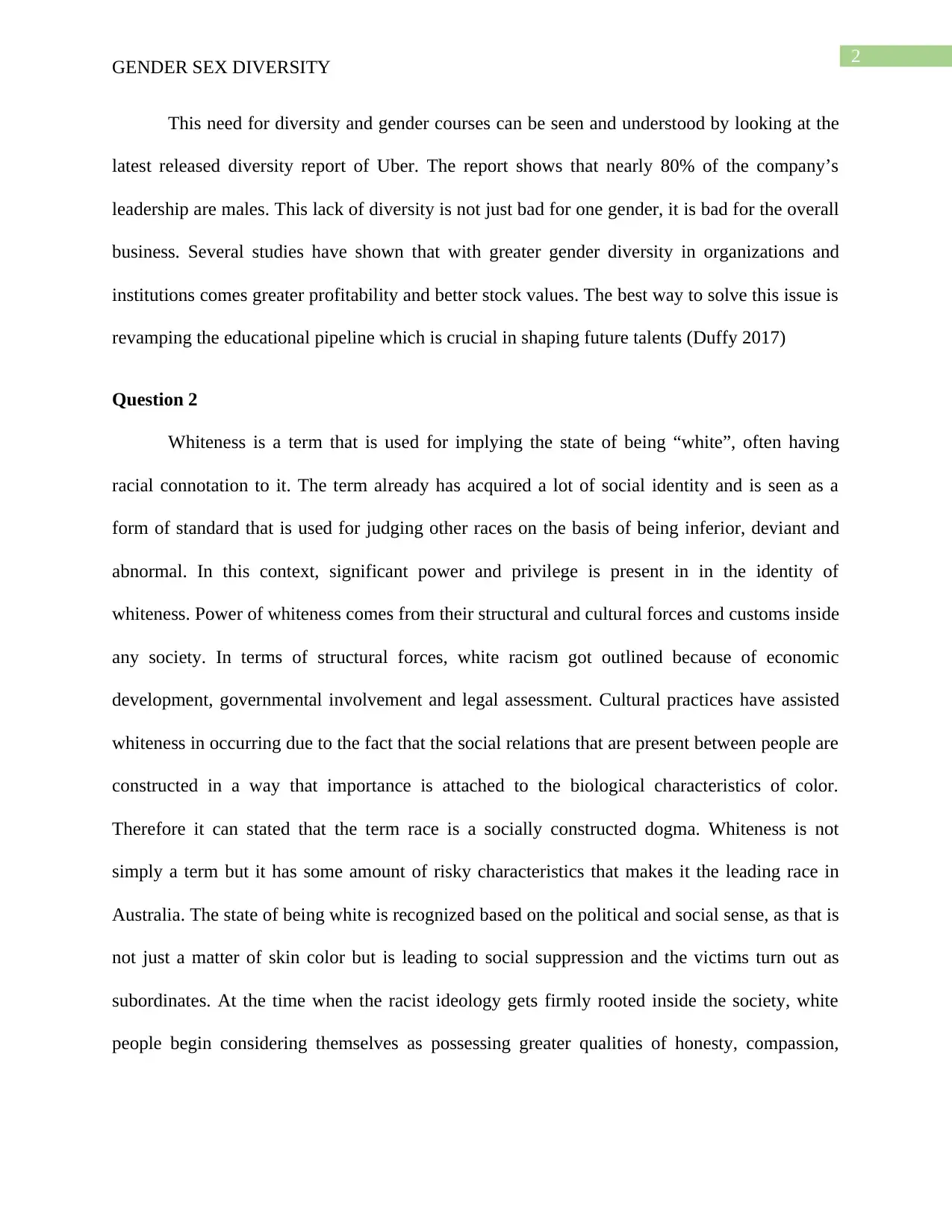
2
GENDER SEX DIVERSITY
This need for diversity and gender courses can be seen and understood by looking at the
latest released diversity report of Uber. The report shows that nearly 80% of the company’s
leadership are males. This lack of diversity is not just bad for one gender, it is bad for the overall
business. Several studies have shown that with greater gender diversity in organizations and
institutions comes greater profitability and better stock values. The best way to solve this issue is
revamping the educational pipeline which is crucial in shaping future talents (Duffy 2017)
Question 2
Whiteness is a term that is used for implying the state of being “white”, often having
racial connotation to it. The term already has acquired a lot of social identity and is seen as a
form of standard that is used for judging other races on the basis of being inferior, deviant and
abnormal. In this context, significant power and privilege is present in in the identity of
whiteness. Power of whiteness comes from their structural and cultural forces and customs inside
any society. In terms of structural forces, white racism got outlined because of economic
development, governmental involvement and legal assessment. Cultural practices have assisted
whiteness in occurring due to the fact that the social relations that are present between people are
constructed in a way that importance is attached to the biological characteristics of color.
Therefore it can stated that the term race is a socially constructed dogma. Whiteness is not
simply a term but it has some amount of risky characteristics that makes it the leading race in
Australia. The state of being white is recognized based on the political and social sense, as that is
not just a matter of skin color but is leading to social suppression and the victims turn out as
subordinates. At the time when the racist ideology gets firmly rooted inside the society, white
people begin considering themselves as possessing greater qualities of honesty, compassion,
GENDER SEX DIVERSITY
This need for diversity and gender courses can be seen and understood by looking at the
latest released diversity report of Uber. The report shows that nearly 80% of the company’s
leadership are males. This lack of diversity is not just bad for one gender, it is bad for the overall
business. Several studies have shown that with greater gender diversity in organizations and
institutions comes greater profitability and better stock values. The best way to solve this issue is
revamping the educational pipeline which is crucial in shaping future talents (Duffy 2017)
Question 2
Whiteness is a term that is used for implying the state of being “white”, often having
racial connotation to it. The term already has acquired a lot of social identity and is seen as a
form of standard that is used for judging other races on the basis of being inferior, deviant and
abnormal. In this context, significant power and privilege is present in in the identity of
whiteness. Power of whiteness comes from their structural and cultural forces and customs inside
any society. In terms of structural forces, white racism got outlined because of economic
development, governmental involvement and legal assessment. Cultural practices have assisted
whiteness in occurring due to the fact that the social relations that are present between people are
constructed in a way that importance is attached to the biological characteristics of color.
Therefore it can stated that the term race is a socially constructed dogma. Whiteness is not
simply a term but it has some amount of risky characteristics that makes it the leading race in
Australia. The state of being white is recognized based on the political and social sense, as that is
not just a matter of skin color but is leading to social suppression and the victims turn out as
subordinates. At the time when the racist ideology gets firmly rooted inside the society, white
people begin considering themselves as possessing greater qualities of honesty, compassion,
⊘ This is a preview!⊘
Do you want full access?
Subscribe today to unlock all pages.

Trusted by 1+ million students worldwide
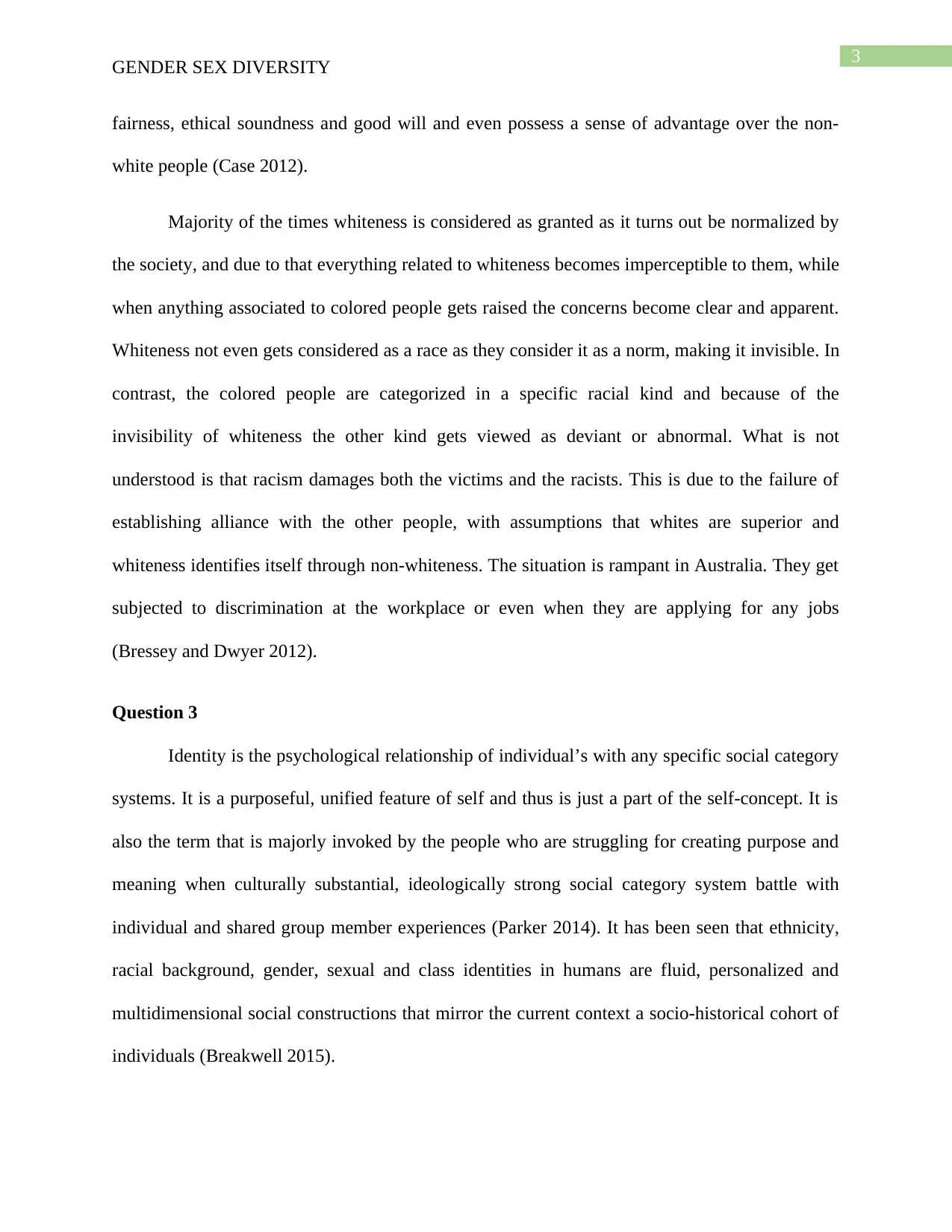
3
GENDER SEX DIVERSITY
fairness, ethical soundness and good will and even possess a sense of advantage over the non-
white people (Case 2012).
Majority of the times whiteness is considered as granted as it turns out be normalized by
the society, and due to that everything related to whiteness becomes imperceptible to them, while
when anything associated to colored people gets raised the concerns become clear and apparent.
Whiteness not even gets considered as a race as they consider it as a norm, making it invisible. In
contrast, the colored people are categorized in a specific racial kind and because of the
invisibility of whiteness the other kind gets viewed as deviant or abnormal. What is not
understood is that racism damages both the victims and the racists. This is due to the failure of
establishing alliance with the other people, with assumptions that whites are superior and
whiteness identifies itself through non-whiteness. The situation is rampant in Australia. They get
subjected to discrimination at the workplace or even when they are applying for any jobs
(Bressey and Dwyer 2012).
Question 3
Identity is the psychological relationship of individual’s with any specific social category
systems. It is a purposeful, unified feature of self and thus is just a part of the self-concept. It is
also the term that is majorly invoked by the people who are struggling for creating purpose and
meaning when culturally substantial, ideologically strong social category system battle with
individual and shared group member experiences (Parker 2014). It has been seen that ethnicity,
racial background, gender, sexual and class identities in humans are fluid, personalized and
multidimensional social constructions that mirror the current context a socio-historical cohort of
individuals (Breakwell 2015).
GENDER SEX DIVERSITY
fairness, ethical soundness and good will and even possess a sense of advantage over the non-
white people (Case 2012).
Majority of the times whiteness is considered as granted as it turns out be normalized by
the society, and due to that everything related to whiteness becomes imperceptible to them, while
when anything associated to colored people gets raised the concerns become clear and apparent.
Whiteness not even gets considered as a race as they consider it as a norm, making it invisible. In
contrast, the colored people are categorized in a specific racial kind and because of the
invisibility of whiteness the other kind gets viewed as deviant or abnormal. What is not
understood is that racism damages both the victims and the racists. This is due to the failure of
establishing alliance with the other people, with assumptions that whites are superior and
whiteness identifies itself through non-whiteness. The situation is rampant in Australia. They get
subjected to discrimination at the workplace or even when they are applying for any jobs
(Bressey and Dwyer 2012).
Question 3
Identity is the psychological relationship of individual’s with any specific social category
systems. It is a purposeful, unified feature of self and thus is just a part of the self-concept. It is
also the term that is majorly invoked by the people who are struggling for creating purpose and
meaning when culturally substantial, ideologically strong social category system battle with
individual and shared group member experiences (Parker 2014). It has been seen that ethnicity,
racial background, gender, sexual and class identities in humans are fluid, personalized and
multidimensional social constructions that mirror the current context a socio-historical cohort of
individuals (Breakwell 2015).
Paraphrase This Document
Need a fresh take? Get an instant paraphrase of this document with our AI Paraphraser
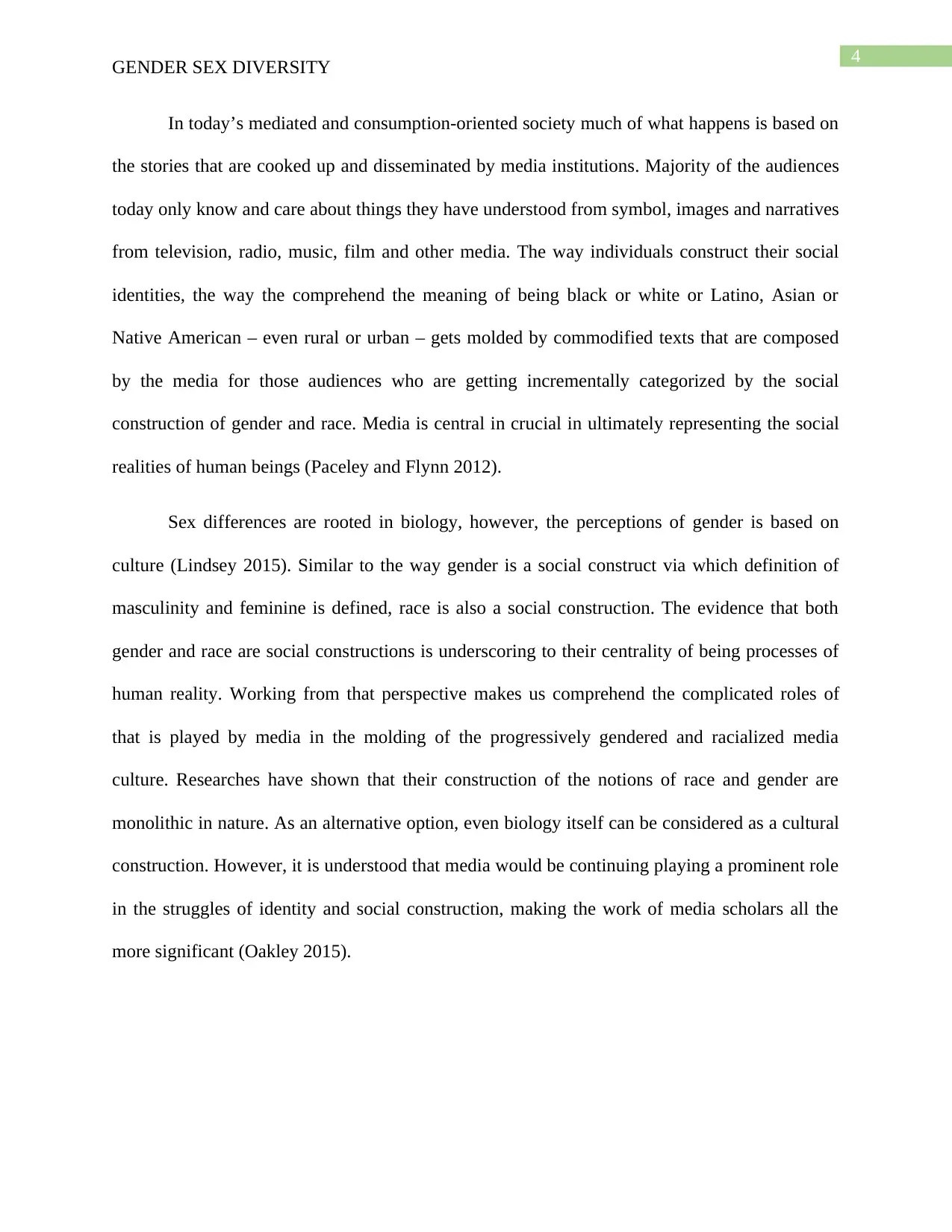
4
GENDER SEX DIVERSITY
In today’s mediated and consumption-oriented society much of what happens is based on
the stories that are cooked up and disseminated by media institutions. Majority of the audiences
today only know and care about things they have understood from symbol, images and narratives
from television, radio, music, film and other media. The way individuals construct their social
identities, the way the comprehend the meaning of being black or white or Latino, Asian or
Native American – even rural or urban – gets molded by commodified texts that are composed
by the media for those audiences who are getting incrementally categorized by the social
construction of gender and race. Media is central in crucial in ultimately representing the social
realities of human beings (Paceley and Flynn 2012).
Sex differences are rooted in biology, however, the perceptions of gender is based on
culture (Lindsey 2015). Similar to the way gender is a social construct via which definition of
masculinity and feminine is defined, race is also a social construction. The evidence that both
gender and race are social constructions is underscoring to their centrality of being processes of
human reality. Working from that perspective makes us comprehend the complicated roles of
that is played by media in the molding of the progressively gendered and racialized media
culture. Researches have shown that their construction of the notions of race and gender are
monolithic in nature. As an alternative option, even biology itself can be considered as a cultural
construction. However, it is understood that media would be continuing playing a prominent role
in the struggles of identity and social construction, making the work of media scholars all the
more significant (Oakley 2015).
GENDER SEX DIVERSITY
In today’s mediated and consumption-oriented society much of what happens is based on
the stories that are cooked up and disseminated by media institutions. Majority of the audiences
today only know and care about things they have understood from symbol, images and narratives
from television, radio, music, film and other media. The way individuals construct their social
identities, the way the comprehend the meaning of being black or white or Latino, Asian or
Native American – even rural or urban – gets molded by commodified texts that are composed
by the media for those audiences who are getting incrementally categorized by the social
construction of gender and race. Media is central in crucial in ultimately representing the social
realities of human beings (Paceley and Flynn 2012).
Sex differences are rooted in biology, however, the perceptions of gender is based on
culture (Lindsey 2015). Similar to the way gender is a social construct via which definition of
masculinity and feminine is defined, race is also a social construction. The evidence that both
gender and race are social constructions is underscoring to their centrality of being processes of
human reality. Working from that perspective makes us comprehend the complicated roles of
that is played by media in the molding of the progressively gendered and racialized media
culture. Researches have shown that their construction of the notions of race and gender are
monolithic in nature. As an alternative option, even biology itself can be considered as a cultural
construction. However, it is understood that media would be continuing playing a prominent role
in the struggles of identity and social construction, making the work of media scholars all the
more significant (Oakley 2015).
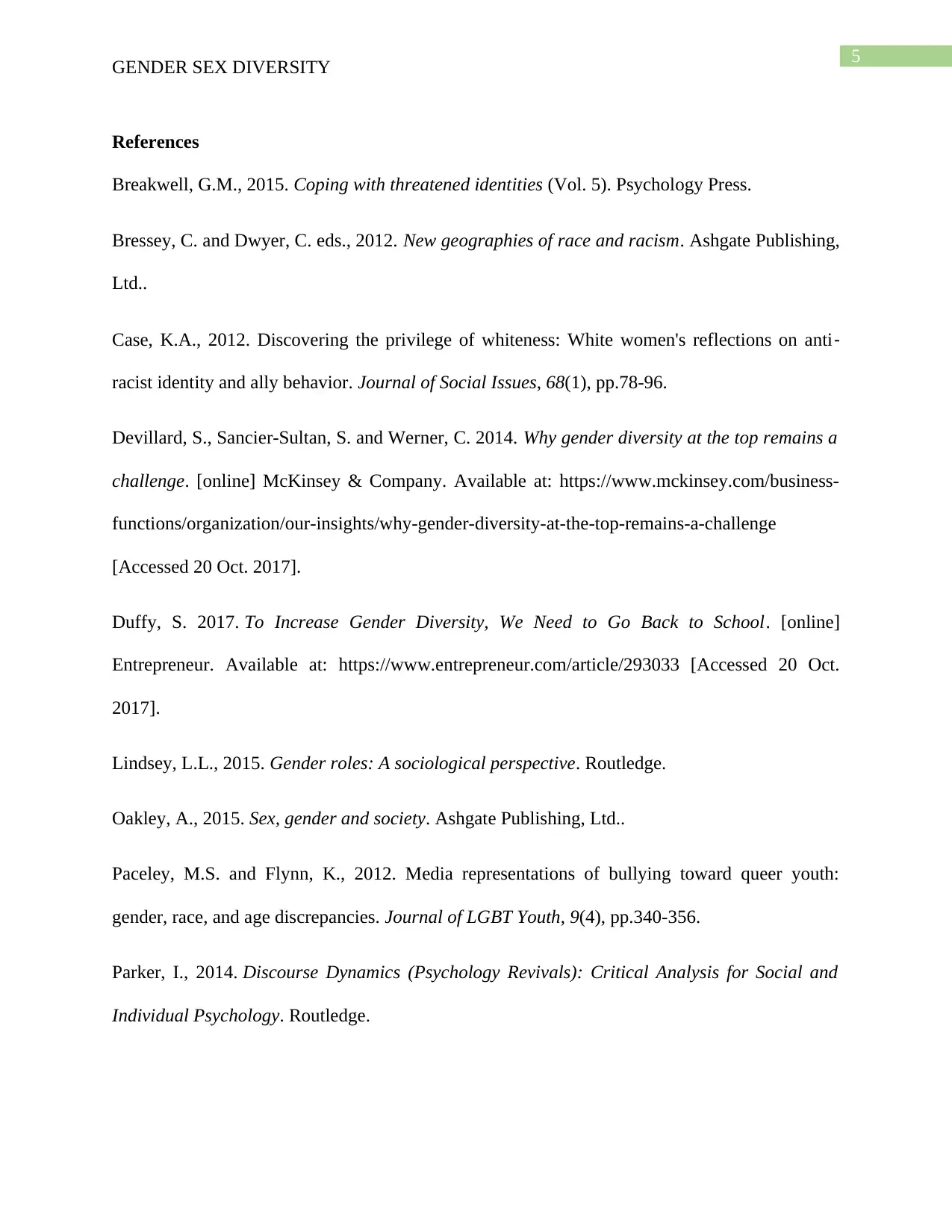
5
GENDER SEX DIVERSITY
References
Breakwell, G.M., 2015. Coping with threatened identities (Vol. 5). Psychology Press.
Bressey, C. and Dwyer, C. eds., 2012. New geographies of race and racism. Ashgate Publishing,
Ltd..
Case, K.A., 2012. Discovering the privilege of whiteness: White women's reflections on anti‐
racist identity and ally behavior. Journal of Social Issues, 68(1), pp.78-96.
Devillard, S., Sancier-Sultan, S. and Werner, C. 2014. Why gender diversity at the top remains a
challenge. [online] McKinsey & Company. Available at: https://www.mckinsey.com/business-
functions/organization/our-insights/why-gender-diversity-at-the-top-remains-a-challenge
[Accessed 20 Oct. 2017].
Duffy, S. 2017. To Increase Gender Diversity, We Need to Go Back to School. [online]
Entrepreneur. Available at: https://www.entrepreneur.com/article/293033 [Accessed 20 Oct.
2017].
Lindsey, L.L., 2015. Gender roles: A sociological perspective. Routledge.
Oakley, A., 2015. Sex, gender and society. Ashgate Publishing, Ltd..
Paceley, M.S. and Flynn, K., 2012. Media representations of bullying toward queer youth:
gender, race, and age discrepancies. Journal of LGBT Youth, 9(4), pp.340-356.
Parker, I., 2014. Discourse Dynamics (Psychology Revivals): Critical Analysis for Social and
Individual Psychology. Routledge.
GENDER SEX DIVERSITY
References
Breakwell, G.M., 2015. Coping with threatened identities (Vol. 5). Psychology Press.
Bressey, C. and Dwyer, C. eds., 2012. New geographies of race and racism. Ashgate Publishing,
Ltd..
Case, K.A., 2012. Discovering the privilege of whiteness: White women's reflections on anti‐
racist identity and ally behavior. Journal of Social Issues, 68(1), pp.78-96.
Devillard, S., Sancier-Sultan, S. and Werner, C. 2014. Why gender diversity at the top remains a
challenge. [online] McKinsey & Company. Available at: https://www.mckinsey.com/business-
functions/organization/our-insights/why-gender-diversity-at-the-top-remains-a-challenge
[Accessed 20 Oct. 2017].
Duffy, S. 2017. To Increase Gender Diversity, We Need to Go Back to School. [online]
Entrepreneur. Available at: https://www.entrepreneur.com/article/293033 [Accessed 20 Oct.
2017].
Lindsey, L.L., 2015. Gender roles: A sociological perspective. Routledge.
Oakley, A., 2015. Sex, gender and society. Ashgate Publishing, Ltd..
Paceley, M.S. and Flynn, K., 2012. Media representations of bullying toward queer youth:
gender, race, and age discrepancies. Journal of LGBT Youth, 9(4), pp.340-356.
Parker, I., 2014. Discourse Dynamics (Psychology Revivals): Critical Analysis for Social and
Individual Psychology. Routledge.
⊘ This is a preview!⊘
Do you want full access?
Subscribe today to unlock all pages.

Trusted by 1+ million students worldwide
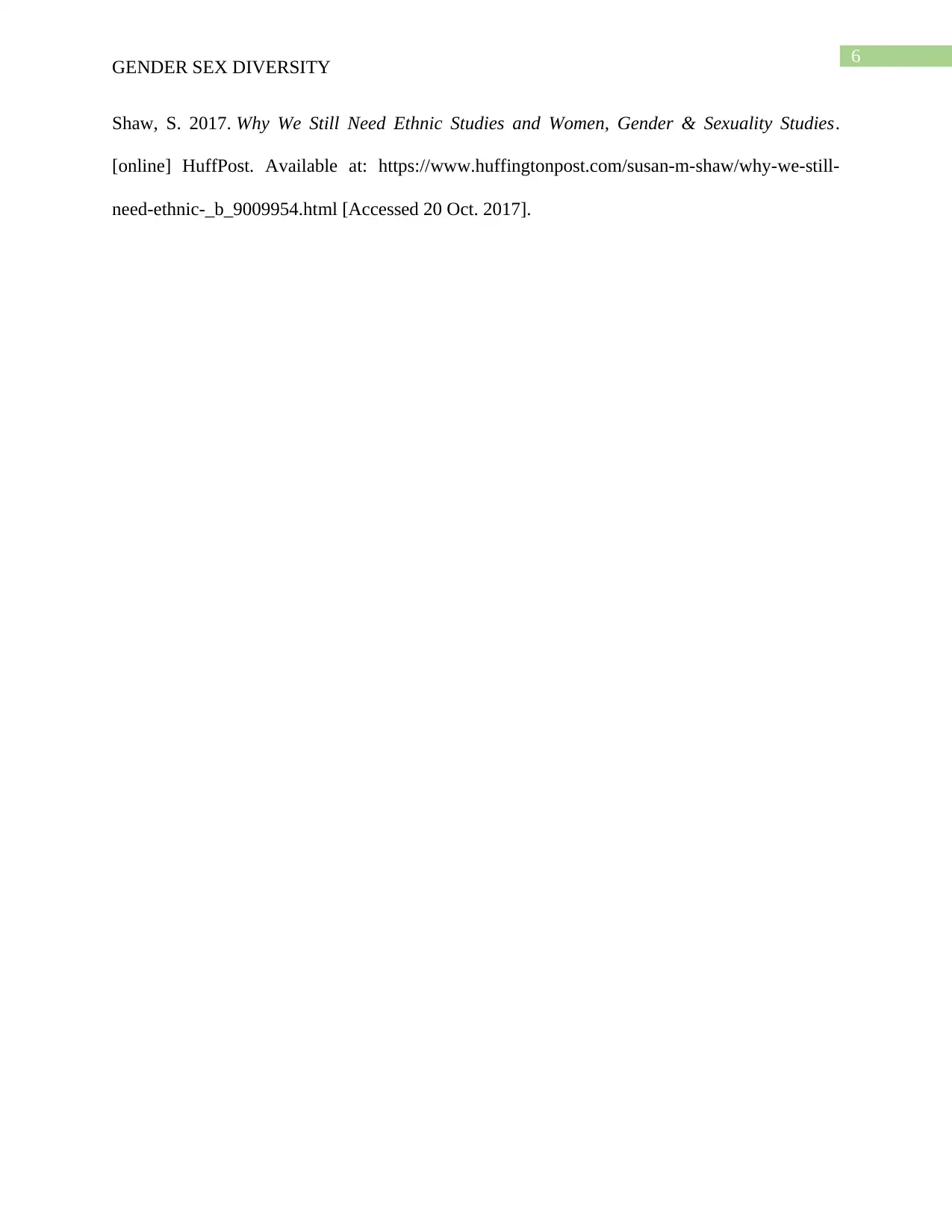
6
GENDER SEX DIVERSITY
Shaw, S. 2017. Why We Still Need Ethnic Studies and Women, Gender & Sexuality Studies.
[online] HuffPost. Available at: https://www.huffingtonpost.com/susan-m-shaw/why-we-still-
need-ethnic-_b_9009954.html [Accessed 20 Oct. 2017].
GENDER SEX DIVERSITY
Shaw, S. 2017. Why We Still Need Ethnic Studies and Women, Gender & Sexuality Studies.
[online] HuffPost. Available at: https://www.huffingtonpost.com/susan-m-shaw/why-we-still-
need-ethnic-_b_9009954.html [Accessed 20 Oct. 2017].
1 out of 7
Related Documents
Your All-in-One AI-Powered Toolkit for Academic Success.
+13062052269
info@desklib.com
Available 24*7 on WhatsApp / Email
![[object Object]](/_next/static/media/star-bottom.7253800d.svg)
Unlock your academic potential
Copyright © 2020–2025 A2Z Services. All Rights Reserved. Developed and managed by ZUCOL.





